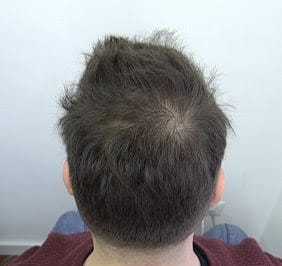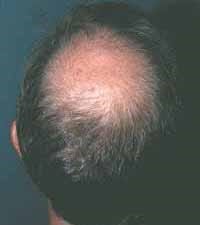Information AboutMale Pattern Hair Loss

Male Pattern Hair Loss

Male Pattern Hair Loss
Male Pattern Hair Loss - Jerry Shapiro, MD
See FAQs at the bottom of the page.
Male pattern hair loss (MPHL) scientifically known as androgenetic alopecia, is the most common form of hair loss in men. MPHL represents close to 95% of all hair loss experienced by men. This progressive loss of hair eventually results in the thinning and/or loss of hair at the front or top of the scalp. Hairs tend to miniaturize or downsize in these areas.
As many as 50% of men are affected by MPHL by age 50. Hair loss can begin anytime after puberty, but most commonly begins among men in their mid-twenties.
Hair loss in MPHL is progressive and follows a predictable pattern. During the first stage of hair loss, hair usually recedes from the forehead, eventually forming an "M" shape. Other areas such as the crown may subsequently thin out. There is a classification system which illustrates the standard assessment scale used to determine the stages of hair loss. (Norwood-Hamilton scale)
Male pattern hair loss is caused by genetic and hormonal factors. The genetics can be inherited from either the maternal or paternal sides of the family. Male hormones, known as androgens, also play an important role. Specifically, the male hormone dihydrotestosterone (DHT), can cause progressive miniaturization of the hairs on site - specific areas of the scalp.
Treatments available for MPHL are topical minoxidil solution (Rogaine®), oral finasteride (Propecia®) and hair transplantation.
Rogaine® is a topical agent available without prescription in a 2% or a 5% solution. The 5% solution is known as Rogaine® Extra Strength. Rogaine® works by stimulating specific growth factors within the hair follicle that prevent hair from shedding, maintain the growing phase of the hair cycle and thicken the hair shaft. With Rogaine®2% solution, 26% of men showed moderate to dense regrowth and 33% showed minimal regrowth after 4 months of use. Studies also show that hair counts increase with the 2% solution and even more with the 5% solution. Studies also show a 45% increase in hair weight when using the 5% solution compared to the 2%. In those who respond to minoxidil, regrowth can occur as early as two months following the first application. Men who respond to treatment can expect their hair loss condition to stabilize within one year. Continued use of the medication is necessary to sustain any benefit.
Propecia®is the only prescription medication available for MPHL. It is given in tablet form at a dose of 1 mg daily. It acts by inhibiting DHT, the hormone related to the development of MPHL. It cannot be prescribed for women. Clinical studies show that it is well tolerated, stops hair loss in 90% of men for at least 5 years and can regrow hair in 65% of men. In those who respond to Propecia®, continued use of the product is necessary to sustain benefits. As is the case with minoxidil, halting the medication will continue the hair loss.
Surgical hair replacement, specifically hair transplantation and scalp reduction, is another alternative for MPHL. Hair transplants involve taking hair from an area not susceptible to hair loss and transplanting this hair where hair loss has occurred. The transplanted hair will continue to grow as if it were in its original location. Scalp reduction is a surgical procedure where an area of the bald scalp is removed and the hair bearing scalp rejoined together.
Frequently, medical and surgical therapies are combined to maximize results.
For a proper diagnosis and to best deal with male pattern hair loss, contact your physician.
References:
Male Pattern Hair Loss Frequently Asked Questions:
The following are frequently asked questions on male pattern hair loss. The information provided is not meant to be a substitute for the information obtained at an evaluation and by discussion with a physician, but merely to encourage understanding of this condition. No questions regarding individual scenarios will be answered by the AHRS. No changes in treatment should be undertaken by a patient without discussion first with the patient's physician.
